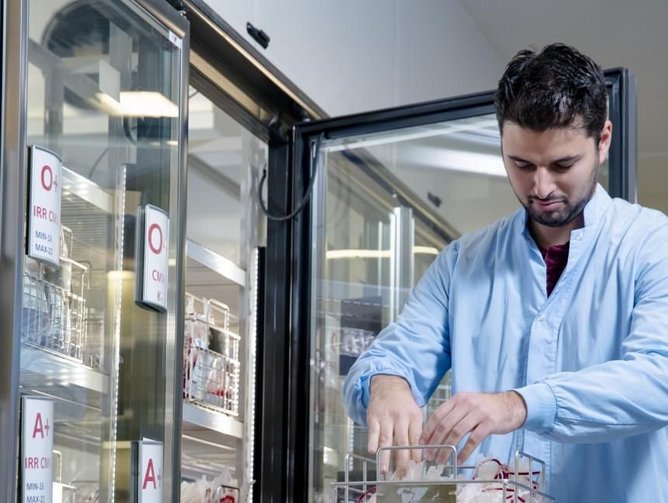How tech innovation is driving donor engagement at the Australian Red Cross Blood Service
One in three Australians will need blood or blood products in their lifetime – yet just one in 30 donates blood. An organisation determined to reverse this trend is the Australian Red Cross Blood Service, a division of the Australian Red Cross which is in the business of saving lives. The organisation supplies communities with safe, life-giving blood and blood products, as well as organ and bone marrow services for transplantation. In fact, the firm collects 25,000 blood donations every week and 1.3mn every year – however, it needs more if it wants to keep up with a growing diverse population.
Wanting to boost donor engagement, the group has pivoted towards IT and digitisation with Philip Nesci, who previously served as CIO at the Blood Service, helping to lead the charge. Nesci is well-equipped for the challenge: he’s presided as CIO for five different companies, overseeing business and technology transformations since the early 1980s. “I’ve been fortunate to have seen many waves of technology innovation,” recalls Nesci. “From PCs and the internet, to mobility and social media, I’ve seen this industry grow from a back-office function to one which is a key part of any business strategy.” Now transitioning to the next stage of his career and moving to Board and Consulting roles, Nesci was keen to reflect on how the Blood Service’s digital transformation can be seen as an exemplary template showing how technology can empower businesses and save lives.
The catalyst for the advent of the Blood Service’s digital roadmap was the appointment of a new Board Chair and Chief Executive, says Nesci noting how “the Blood Service quickly recognised that technology plays a critical role in not only enabling the business but also fundamentally disrupting the organisation.” The first obstacle the group aimed to tackle was a straightforward yet challenging one: improving donor engagement. One of the major channels for interacting with donors is through a National Call Centre, whereby donors can call to make an appointment. However, keen to meet the demands of a digitally savvy nation, the organisation soon realised that online channels and self-service were critical to enhancing donor engagement. It implemented online channels like self-service portals, mobile apps, and chatbots which meant that donors could book an appointment at the touch of a button, anytime, anywhere. “These days, everyone is time poor and online channels give donors the ability to make and change appointments where and when they find it convenient, on any device,” he explains. “In the space of just over 12 months, donors are now making or changing over 30% of their appointments online.”
On top of this, Nesci and his team also helped to spearhead a new cloud-first strategy, leading a steady transition towards cloud services. “It’s a key element of any digital strategy,” he says. “The Blood Service is adopting cloud capabilities to deliver increased agility so that it can better respond to business needs, increase security and tackle the growing volume of data.”
You may not associate blood donation with technology, but Nesci believes the opportunities for innovation are limitless. “You could use voice-enabled online channels, virtual reality (VR) in Donor Centres, and the Internet of Things (IoT) and robotics in manufacturing. You could also use AI and data analytics across all of the Blood Service’s activities – from predicting donor behaviour to genomics matching and supply chain efficiencies,” enthuses Nesci. “Ultimately, this type of innovation will benefit donors and patients, and it will drive improved outcomes for the Blood Service.”
As well as looking at the latest cutting-edge technologies coming to the fore, the Blood Service has also zeroed in on the fundamentals of IT, such as cybersecurity. The Blood Service experienced a cybersecurity threat early in Nesci’s tenure, but luckily the team was well equipped to combat the challenge. “A cybersecurity incident is something no organisation ever wishes to experience,” Nesci says candidly. “Fortunately, we had an outstanding and immediate response from the executive team, the board and the technology team.” Transparency was key to resolving the issue; the Blood Service disclosed the incident within 72 hours and made sure that donors continue to engage with and trust in the organisation. “After the incident, the Blood Service made cybersecurity a top priority and implemented an aggressive cybersecurity capability for detection, response, prevention and governance,” Nesci adds. “One of the notable positives has been that the Blood Service maintained the trust of donors throughout the recovery without reputational damage to the brand.”
To keep up with the blistering pace of innovation, the Blood Service is increasingly and selectively adopting agile approaches to improve the speed of the technology transformation and manage the risks of delivery. With this in mind, a cultural shift was needed. “There is a program in place to raise the organisation’s awareness of Agile,” he says. “With this approach, the Blood Service has recognised that some cultural changes are required both in the ICT team and in the business approaches.” While many firms in IT are finding the war for talent an indefinite struggle, thanks to the Blood Service’s sense of purpose it has been able to tackle this hurdle in its stride. “People want to come to work to make a difference,” Nesci adds. “The Blood Service has developed leaders and delivered outcomes with business partners, but it also has a noble purpose which a lot of people are attracted to.”
Now moving to the next stage of his career, Nesci has passed the baton to the Blood Service’s new CIO, Ann Larkins, ensuring that she can continue to lead the organisation towards a more innovative future. “The next CIO will take this journey to the next level,” he observes. “IT has confidence in the board and the executives, and, in partnership with them, it has delivered some major outcomes around the donor experience. Most recently, the Blood Service launched a new system that will enhance the vital matching service for organ transplantation in Australia; it’s a next-generation tool.”
Traditionally, healthcare has been a slow adopter of technology. But with the growing pervasiveness of cloud, the rise of wearable devices and more, Nesci believes it’s “prime for disruption”. “I think the Blood Service, in particular, will go from strength to strength under the new CIO,” he adds.







